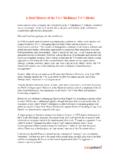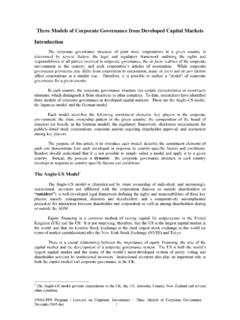Transcription of THE BIOCHEMICAL BASIS OF TENDERNESS IN BEEF: A Ph.D. …
1 THE BIOCHEMICAL BASIS OF TENDERNESS IN BEEF: A PROJECTL omiwes, D., Farouk, M. M., Frost, D. A., oes,,aou,,ost,,Dobbie, P. M. & Young, O. & Bio based Products GroupAgResearch Ruakura Hamilton, New ZealandMeat pH is an indicator of eating qualityUltimate pH (low pH) (intermediate pH)>62 Tender meatInconsistently > (high pH, DFD meat)Tender meatMicrobial spoilageDarkLess profile of new zealand beef cattle Results from a survey of new zealand beef cattle to determinethepHprofileofbeefcattlewithspe cificfocusdetermine the pH profile of beef cattle, with specific focus on bull is pH compartmentalised Why are low and high pHumeat tender? heat shock proteins and toughness in intermediate pHumeat BIOCHEMICAL BASIS for toughness in intermediate pHubeefOverall ultimate pH status of beef in New ZealandSurvey over two years and three different seasons on three representative lhlihNh80100 LowIntermediate High 8694slaughter plants in the North pHuwas measured from the loins samples stored at C at 48 hours after proportion of intermediate and high pHumeat in (n = 1597)Steers (n = 337)Cows (n = 154)
2 068331990199319942009nMean pHunMean pHunMean pHu% low pHunMean pHu% low pHuOverall ultimate pH status of beef in New ZealandAll , about half of new zealand bull beef is intermediate or high has been a progressive decline in intermediate and high pHubulls over the Intermediate High Bullse80100 LowIntermediateHighPlant and seasonal variation in the ultimate pH of bull beefPlant 1 Plant 2 Plant 3 Percentage010203040 Autumn (n = 585)Winter (n = 497)Spring (n = 515)Percentag0204060 The incidence of intermediate and high pHu meat was lower in winter. Overall, Plant 3 had the least percentage of intermediate and high pHubull could be due to several factors:1. Animal handling on farm, transport, lairage2. Meteorological conditions rainfall, temperature3.
3 Seasonal nutritional quality of pastureTenderness in meat is due to degradation of muscle during ageingAt slaughter7 days post mortem28 days post mortemEnzymedegradationofkeymyofibrillar andassociatedproteinsEnzyme degradation of key myofibrillarand associated proteins is the cause of post mortemtendernessThis is why meat is AGED Calpains optimal at near neutral pH Cathepsins optimal at more acidic pH levelsDynamics of calpains and cathepsinsCalpain activityCathepsin activityTotal enzyme activityIntermediate problem with intermediate pHumeat161820 Low (n = 52)Intermediate (n = 14)High (n = 28)On average, intermediate pHutakes longer to attain acceptable Shear force (kgF) pHumeat is more variable in TENDERNESS and a proportion of intermediate pHuwill still be tough even after extended ageingTime post mortem (days)127142824 High pHuis already acceptably tender at 1 day post Meat TENDERNESS is pH pHuINCONSISTENTLY TENDERWhy are high and low pHumeat tender?
4 TENDERT enderness in low and high pHumeat is pH compartmentalisedTenderness in high pHumeat attributed to the rapid degradation of large proteins such as titin and filamin by the enzyme in low and high pHumeat is pH compartmentalisedTenderness in low pHumeat due to a combination of the degradation of large proteins by calpain and smaller proteins by cathepsins at latter ageing Small heat shock proteins and toughness in intermediate pHuHigh pHuWhy is intermediate pH meat inconsistently tender?TENDERTENDERThe slow and less extensive degradation of proteins in intermediate pHumeat results in toughnesssHSP Expression and Meat TendernessReference1 Changes in HSP27 significantly correlated with shear force Hwang et al.(2005)2 HSP27and crystallindown regulatedinmosttenderSmall heat shock proteins and tenderness2 HSP27 and crystallindown regulated in most tenderbeef samples as measured by a sensory etal.
5 (2007)3 HSP27 levels in muscle early post mortemexplained up to 89% of overall sensory TENDERNESS of bull beefMorzelet al.(2008)4 Higher expression of HSP27 in tougher beefKimet. al(2008)5 Higher levels of crystallin in intermediate pHubull beef Pulford etal.(2009)Small heat shock proteins: Abundant in muscle cells Involved in protein repair muscle damage Expression amplified in stressed cells Assist in proper assembly of proteins in living cells crystallin increasing interacts with myofibrils as pH decreases Increasing association of sHSP with myofibrils with decreasing pH Possibly greater sHSP associated with the myofibrils in the intermediate pHumeat Crystallin reduced extent of desmin and titin+ -crystallin- -crystallinDesmin crystallin protects myofibrillar proteins from calpain induced degradation(not shown) degradation by calpain Crystallin may act as an alternative substrate that competitively inhibits calpaindegradation of muscle proteinsDesmin(54 kDa)Desmin(degraded)
6 Gp This results in the less extensive degradation of the muscle structure leading to meat toughnessSummary1. pH Survey of new zealand beef cattle Compared with previous studies, there has been an overall improvement in the pH profile of beef cattle. High prevalence of intermediate and high pHubull beef 19% and 32% respectively. Variation in the pH profile between seasons and TENDERNESS is pH compartmentalised Rapid tenderisation of high pH meat due to the faster and more extensive degradtaion of large myofibrillar proteins (titin, filamin) and desmin by the enzyme calpain. The slower rate of tenderisation in low pH meat due to the slower degradation rates of large myofibrillar proteins by calpain and smaller proteins (desmin) by Small heat shock protein and toughness in intermediate pHubeef crystallin reduced the enzyme degradation of desmin and titin Increasing association of sHSP with myofibrils as pH declined Potential for sHSP protection of myofibrillar proteins from degradation optimal in intermediate pH High incidence of intermediate and high pH bulls suggest they may be more susceptible to stress during transport and lairage.
7 The degradation of proteins that are less abundant in muscle (titin, filamin, desmin) may contribute more to meat TENDERNESS compared with more abundant muscle proteins such as myosin (43% of muscle protein). Will optimising processing conditions to maintain muscle at high pH levels for longer lead to the degradation of muscle proteins resulting in meat TENDERNESS in intermediate pHumeat? Is electrically stimulating muscle inducing the increased expression of small heat shock proteins leading to their contribution tough meat as observed in intermediate pHubeef?Acknowledgments Funding for this project was provided by new zealand Ministry of Science and Innovation (contract number C10X0708) FoodandBioBasedProductsGroup:DrKatjaRose nvoldAdam Food and Bio Based Products Group: Dr.
8 Katja Rosenvold, Adam Stuart, Kevin Taukiri, Guojie Wu and Mohammad Russel. Martin Upsdell for statistical analysis of data Supervisors: Dr. Owen Young and Dr. Eva Wiklu



